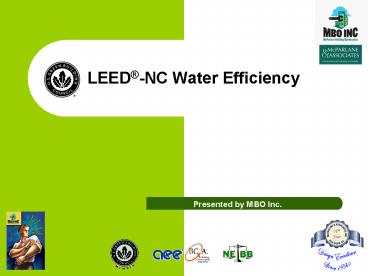LEEDNC Water Efficiency - PowerPoint PPT Presentation
1 / 30
Title:
LEEDNC Water Efficiency
Description:
Where can the Plumbing Engineer make a difference? LEED ... Specify vegetated roofs, pervious paving, and other measures to minimize impervious surfaces. ... – PowerPoint PPT presentation
Number of Views:327
Avg rating:3.0/5.0
Title: LEEDNC Water Efficiency
1
LEED-NC Water Efficiency
Presented by MBO Inc.
2
Your Speakers for Today
- Jorge Torres Coto, LEED AP
- Building Systems Commissioning Engineer
- MBO, Inc.
- jorge_at_mbo1.com
- Brought to you by
- MBO, Inc.
3
Outline
- What is LEED?
- Where can the Plumbing Engineer make a
difference? - LEED Requirements and tips
- SSc6.1
- SSc6.2
- WEc2
- WEc3.1
- WEc3.2
- IDc1.1
- Examples and experience on WE
- Where is LEED going?
4
What is LEED?
- United States Green Building Council
- Leadership in Energy and Environmental Design
- LEED-NC v2.2
- LEED-CI v2.0
- LEED-CS v2.0
- LEED-EB v2.0
- LEED Retail
- LEED Hospitals
- LEED Homes
- LEED Neighborhood Development
5
What is LEED-NC?
- Rating System with five sections
- Sustainable Sites SS
- Water Efficiency WE
- Energy Atmosphere EA
- Materials Resources MR
- Environmental Quality EQ
- Innovation in Design ID
- Resource Management
6
Sustainable Sites
- SSp1 Construction Activity Pollution Prevention
- SSc1 Site Selection
- SSc2 Development Density Community Connectivity
- SSc3 Brownfield Redevelopment
- SSc4 Alternative Transportation
- SSc5 Site Development
- SSc6.1 Storm water Design Quantity Control
- SSc6.2 Storm water Design Quality Control
- SSc7 Heat Island Effect
- SSc8 Light Pollution Reduction
7
Water Efficiency
- WEc1 Water Efficient Landscaping
- WEc2 Innovative Wastewater Technologies
- WEc3.1 Water Use Reduction 20 Reduction
- WEc3.2 Water Use Reduction 30 Reduction
8
Energy Atmosphere
- EAp1 Fundamental Building Commissioning
- EAp2 Minimum Energy Performance
- EAp3 Fundamental Refrigerant Management
- EAc1 Optimize Energy Performance
- EAc2 On site Renewable Energy
- EAc3 Enhanced Commissioning
- EAc4 Enhanced Refrigerant Management
- EAc5 Measurement Verification
- EAc6 Green Power
9
Material Resources
- MRp1 Storage Collection of Recyclables
- MRc1 Building Reuse
- MRc2 Construction Waste Management
- MRc3 Materials Reuse
- MRc4 Recycled Content
- MRc5 Regional Material
- MRc6 Rapidly Renewable Materials
- MRc7 Certified Wood
10
Indoor Environmental Quality
- EQp1 Minimum IAQ Performance
- EQp2 Environmental Tobacco Smoke Control
- EQc1 Outdoor Air Delivery Monitoring
- EQc2 Increased Ventilation
- EQc3 Construction IAQ Management Plan
- EQc4 Low-Emitting Materials
- EQc5 Indoor Chemical Pollutant Source Control
- EQc6 Controllability of Systems
- EQc7 Thermal Comfort
- EQc8 Daylight Views
11
Innovation in Design
- IDc1-4 Water Use Reduction 40 Reduction
- EQc2 LEED Accredited Professional
12
SSc6.1 Storm Water Design
- Quality Control
- Credit Intent
- Limit disruption of natural hydrology by reducing
the impervious cover, increasing on-site
infiltration, and managing storm water runoff. - Potential Technologies Strategies
- Design the project site to maintain natural storm
water flows by promoting infiltration. - Specify vegetated roofs, pervious paving, and
other measures to minimize impervious surfaces. - Reuse storm water volumes generated for
non-potable uses such as landscape irrigation,
toilet and urinal flushing and custodial uses.
13
SSc6.1 Storm Water Design
14
SSc6.1 Storm Water Design
15
SSc6.1 Storm Water Design
- VrVolume Runoff
- AArea
- QrDrawdown rate
16
SSc6.2 Storm Water Design
- Quantity Control
- Credit Intent
- Reduce or eliminate water pollution by reducing
impervious cover, increasing on site
infiltration, eliminating sources of
contaminants, and removing pollutants from storm
water runoff. - Potential Technologies Strategies
- Specify vegetated roofs, pervious paving, and
other measures to minimize impervious surfaces
and promote infiltration, thereby reducing
pollutant loadings. - Use sustainable design strategies to design
integrated natural and mechanical treatment
systems such as constructed wetlands, vegetated
filters, and open channels to treat storm water
runoff.
17
SSc6.1 6.2 Storm Water Design
- References
- www.epa.gov/ORD/NRMRL/pubs/600r04121/600r04121a.pd
f - www.mde.state.md.us/Programs/WaterPrograms/Sedimen
tandStormwater/stormwater_design/index.asp
18
WEc2 Innovative Wastewater Technologies
- Intent
- Reduce generation of wastewater and potable water
demand, while increasing the local aquifer
recharge. - Technologies Strategies
- Specify high-efficiency fixtures and dry fixtures
such as composting toilet systems and non-water
utilizing urinals to reduce wastewater volumes. - Consider reusing storm water or grey water for
sewage conveyance or on-site wastewater treatment
systems.
19
WEc2 Innovative Wastewater Technologies
- Full Time Equivalent building occupants
- FTE (8 hour, part time is proportional)
- Establish Baseline Calculation (EPA-1992)
- Establish Proposed Calculation
- Calculate differential between Baseline
Proposed Design
20
WEc2 Innovative Wastewater Technologies
21
WEc2 Innovative Wastewater Technologies
22
WEc2 Innovative Wastewater Technologies
23
WEc2 Innovative Wastewater Technologies
24
WEc2 Innovative Wastewater Technologies
- References
- www.epa.gov/owm/septic/pubs/septic_2002_osdm_all.p
df - www.arcsa-usa.org
25
WEc3.1 3.2 Water Use Reduction
- Intent
- Maximize water efficiency within the buildings to
reduce the burden of municipal water supply and
wastewater systems. - Technologies and Strategies
- Use high-efficiency fixtures, dry fixtures such
as composting toilet systems and non water
consuming urinals, and occupant sensors to reduce
the potable water demand. - Consider reuse of storm water and gray water for
non potable applications.
26
WEc3.1 3.2 Water Use Reduction
- Full Time Equivalent building occupants
- FTE (8 hour, part time is proportional)
- Establish Baseline Calculation (EPA-1992)
- Establish Proposed Calculation
- Calculate differential between Baseline
Proposed Design
27
WEc3.1 3.2 Water Use Reduction
28
WEc3.1 3.2 Water Use Reduction
- Familiarize yourself with the calculators and
definitions. - We are the experts according to architect / owner
29
Open Forum
- Questions?Comments?Complaints?Praises?
30
THANK YOU
- MBO INC.
- 4619 Viewridge Avenue, Suite C
- San Diego, CA 92071
- 858.751.0933
- jorge_at_mbo1.com































